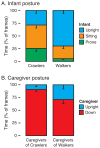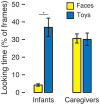See and be seen: Infant-caregiver social looking during locomotor free play
- PMID: 29071760
- PMCID: PMC5920801
- DOI: 10.1111/desc.12626
See and be seen: Infant-caregiver social looking during locomotor free play
Abstract
Face-to-face interaction between infants and their caregivers is a mainstay of developmental research. However, common laboratory paradigms for studying dyadic interaction oversimplify the act of looking at the partner's face by seating infants and caregivers face to face in stationary positions. In less constrained conditions when both partners are freely mobile, infants and caregivers must move their heads and bodies to look at each other. We hypothesized that face looking and mutual gaze for each member of the dyad would decrease with increased motor costs of looking. To test this hypothesis, 12-month-old crawling and walking infants and their parents wore head-mounted eye trackers to record eye movements of each member of the dyad during locomotor free play in a large toy-filled playroom. Findings revealed that increased motor costs decreased face looking and mutual gaze: Each partner looked less at the other's face when their own posture or the other's posture required more motor effort to gain visual access to the other's face. Caregivers mirrored infants' posture by spending more time down on the ground when infants were prone, perhaps to facilitate face looking. Infants looked more at toys than at their caregiver's face, but caregivers looked at their infant's face and at toys in equal amounts. Furthermore, infants looked less at toys and faces compared to studies that used stationary tasks, suggesting that the attentional demands differ in an unconstrained locomotor task. Taken together, findings indicate that ever-changing motor constraints affect real-life social looking.
© 2017 John Wiley & Sons Ltd.
Figures





References
-
- Adolph KE, Robinson SR. Motor development. In: Liben L, Muller U, editors. Handbook of child psychology and developmental science. 7. Vol. 2. New York: Wiley; 2015. pp. 114–157. Cognitive Processes.
Publication types
MeSH terms
Grants and funding
LinkOut - more resources
Full Text Sources
Other Literature Sources
Medical

